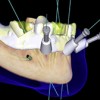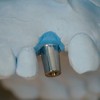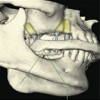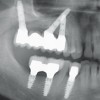Transcript of “Implants and RPDs”
1. Implants and RPD’s John Beumer III DDS, MS Ting Ling Chang DDS Robert Faulkner DDS Division of Advanced Prosthodontics, UCLA This program of instruc1on is protected by copyright ©. No por1on of this program of instruc1on may be reproduced, recorded or transferred by any means electronic, digital, photographic, mechanical etc., or by any informa1on storage or retrieval system, without prior permission.
2. Implants have been used under following circumstances in conjunc1on with RPD’s. • In extension base RPD’s (Kennedy Class I and II) to supplement the support, stability and reten1on provided by the exis1ng den11on. • Implants with ques1onable anchorage and configura1ons with unfavorable biomechanics • Unan1cipated implant failures in key loca1ons • Replacement for a key natural tooth abutment • As a supplement when the exis1ng den11on cannot provide sufficient support, stability and reten1on for the removable prosthesis Implants and RPD’s
3. In extension base RPD’s (Kennedy Class I and II) to supplement the support, stability and reten1on provided by the exis1ng den11on. Position and lengths • Implant site most favored – 1st molar position • Lengths vary but in recent times some clinicians have reported successful outcomes when using implants as short as 6 mm in length (Gates et al, 2012).
4. In extension base RPD’s (Kennedy Class I and II) to supplement the support, stability and reten1on provided by the exis1ng den11on. Prosthodon1c issues • Resilient aNachments • Provide both reten1on and stability with less risk of implant overload (Cho, et al 2002) • Cover the retromolar pad and the buccal shelf • Provides ample support • RPD should be designed with guide planes, proximal plates and posi1ve rests on natural tooth abutments
5. In extension base RPD’s (Kennedy Class I and II) to supplement the support, stability and reten1on provided by the exis1ng den11on. Complica1ons (Gates, et al, 2012) • Peri-‐implan11s • Loosening abutments • Wear aNachments • Occasional implant loss
6. Implants with ques1onable anchorage and configura1ons with unfavorable biomechanics Why overlay RDP? – GraXed implant sites – Unfavorable crown implant ra1os – Linear configura1on – Bracing (cross arch stabiliza1on
7. Implants with ques1onable anchorage and configura1ons with unfavorable biomechanics • Implant connec1ng bar designed to be implant assisted • Note posi1ve cingulum rest was placed on the canine an a pothole rest on the lateral inicsor
8. Implants with ques1onable anchorage and configura1ons with unfavorable biomechanics • Defini1ve prosthesis
9. Unan1cipated implant failures in key loca1ons • Two implants were lost on each side and the pa1ent chose not to undergo addi1onal surgery • Posi1ve cingulum rests were placed on each central (the central incisors were splinted) and the posterior molars • The aNachments were resilient and were primarily used for reten1on so as to avoid placement of retainers anteriorly
10. Defini1ve prosthesis – Note: The aNachments were designed to be engaged on the same plane as the path of inser1on of the RPD framework Unan1cipated implant failures in key loca1ons
11. • Implant supported removable par1al dentures
12. Replacement for a key natural tooth abutment • On some occasions a key abutment tooth on one side of the arch used to support and retain a removable par1al denture is lost. • If the remaining teeth on that side of the arch are not suitable abutments for a removable par1al denture the authors have replaced the tooth with an implant/s.
13. Replacement for a key natural tooth abutment • Note the use of resilient aNachment
14. Replacement for a key natural tooth abutment l Note the use of resilient aNachments
15. As a supplement when the exis1ng den11on cannot provide sufficient support, stability and reten1on for the removable prosthesis • Remaining maxillary molars compromised periodontally • Large RPD obturator • Note the rests on the bar
16. Overlay Removable Partial Dentures Note: • Anterior open bite • Fistulas • Soft palate defect
17. Overlay Removable Partial Dentures v Remaining teeth covered with gold copings. v Tooth tissue junction should be covered with metal as opposed to acrylic resin v Implants placed in posterior quadrant.
18. Design of the metal framework Note that the tooth 1ssue junc1on of all overlaid teeth are covered with metal as opposed to acrylic resin. The resin is porous and if you cover these areas with this material you will increase the risk of gingival caries Note the metal occlusal surfaces overlaying the implant connec1ng bar. This was done to accommodate for the lack of space between the implant connec1ng bar and the opposing natural den11on.
19. Definitive prosthesis. Overlay Removable Partial Dentures
20. Overlay RPD’s
21. Defini1ve prosthesis
22. As a supplement when the exis1ng den11on cannot provide sufficient support, stability and reten1on for the removable prosthesis
23. • Implants were placed with the aid of a surgical template so they were aligned consistent with the path of inser1on of the RPD As a supplement when the exis1ng den11on cannot provide sufficient support, stability and reten1on for the removable prosthesis
24. Defini1ve prosthesis
25. v Visit ffofr.org for hundreds of addi1onal lectures on Complete Dentures, Fixed Prosthodon1cs, Implant Den1stry, Removable Par1al Dentures, Esthe1c Den1stry and Maxillofacial Prosthe1cs. v The lectures are free. v Our objec1ve is to create the best and most comprehensive online programs of instruc1on in Prosthodon1cs


 Computer Guided Treatment Planning and Surgery
Computer Guided Treatment Planning and Surgery
 Cement Retention vs Screw Retention
Cement Retention vs Screw Retention
 Angled Implants
Angled Implants
 Restoration of Posterior Quadrants and Treatment Planning
Restoration of Posterior Quadrants and Treatment Planning
